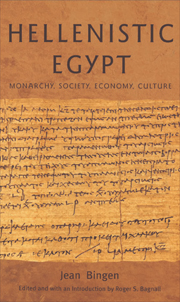Book contents
- Frontmatter
- Contents
- Original Sources of Chapters
- List of illustrations
- Glossary
- Maps
- Foreword
- Introduction: Jean Bingen and the currents of Ptolemaic history
- Part I The Monarchy
- Part II The Greeks
- Part III The Royal Economy
- Part IV Greeks and Egyptians
- 16 Greek economy and Egyptian society in the third century
- 17 Greeks and Egyptians according to PSI V 502
- 18 Graeco-Roman Egypt and the question of cultural interactions
- 19 Normality and distinctiveness in the epigraphy of Greek and Roman Egypt
- Conclusion
- Bibliography
- General index
- Index of passages discussed
- HELLENISTIC CULTURE AND SOCIETY
19 - Normality and distinctiveness in the epigraphy of Greek and Roman Egypt
from Part IV - Greeks and Egyptians
- Frontmatter
- Contents
- Original Sources of Chapters
- List of illustrations
- Glossary
- Maps
- Foreword
- Introduction: Jean Bingen and the currents of Ptolemaic history
- Part I The Monarchy
- Part II The Greeks
- Part III The Royal Economy
- Part IV Greeks and Egyptians
- 16 Greek economy and Egyptian society in the third century
- 17 Greeks and Egyptians according to PSI V 502
- 18 Graeco-Roman Egypt and the question of cultural interactions
- 19 Normality and distinctiveness in the epigraphy of Greek and Roman Egypt
- Conclusion
- Bibliography
- General index
- Index of passages discussed
- HELLENISTIC CULTURE AND SOCIETY
Summary
This chapter, originally written for a colloquium in Bologna devoted to Egypt's place in the larger framework of ancient history, considers the attitude and concerns of the historian facing a pair of connected phenomena: on the one hand, the body of Greek and Roman inscriptions found in Egypt, a huge set of texts which by their mere existence imposes on scholars a duty to have them published and duly commented, and, on the other hand, the potential of this epigraphy to be used as a specific item of evidence, subjected to the normal rules of documentary and historical criticism, but according to a particular methodological approach dictated by local institutional and cultural conditions.
I will discuss this problem within the traditional chronological range of ‘papyrology’, the millennium which begins with Alexander the Great's arrival in Egypt and ends some decades after the Arabic conquest. But we should not forget that before the arrival of the Macedonian conqueror, in the archaic and later in the classical period, Greek inscriptions were set up or cut on monuments as far south as Nubian Abu Simbel, and that in Naucratis and in the area of Memphis Greek inscriptions as well as coin hoards witness to either the temporary presence of Greek mercenaries or merchants in Egypt or their first permanent settlements in the Delta or in the Nile valley.
- Type
- Chapter
- Information
- Hellenistic EgyptMonarchy, Society, Economy, Culture, pp. 256 - 278Publisher: Edinburgh University PressPrint publication year: 2007



